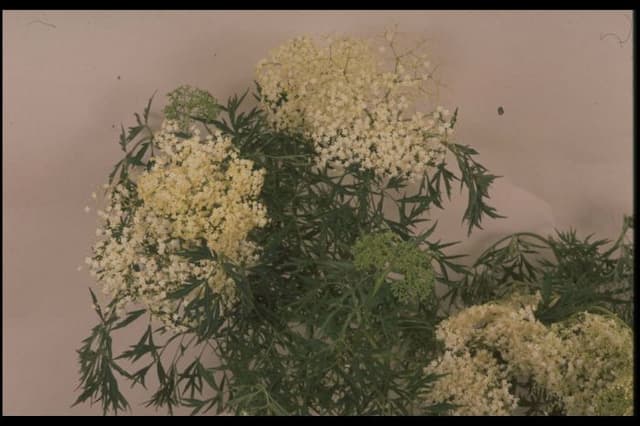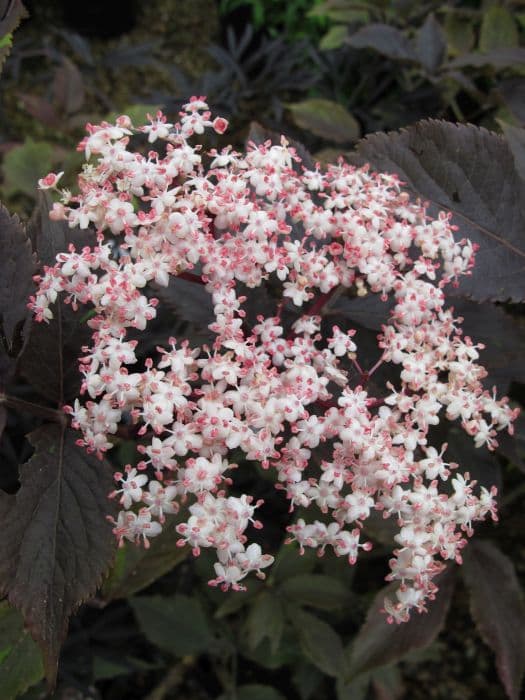Brandywine Viburnum Viburnum nudum Brandywine = 'Bulk'
![withe rod [Brandywine]](/_next/image?url=https%3A%2F%2Fplants-admin.emdemapps.com%2Fimages%2Fplants%2F%2Fimages%2F604b5f767d45c.png&w=3840&q=75)
ABOUT
The Brandywine Viburnum is a visually striking shrub, known for its multi-seasonal interest. This plant features medium green, glossy leaves that add a lush backdrop to the garden landscape. As the seasons change, its foliage transitions into a dramatic display of reds and purples, creating an eye-catching autumn tableau. One of the most captivating attributes of the Brandywine Viburnum is its berries. The plant produces clusters of berries that emerge in a vivid shade of green, gradually maturing to a bright shade of pink and eventually deepening to a rich blue. This unique transformation results in a stunning contrast of pink and blue berries coexisting on the plant simultaneously. The flowers of the Brandywine Viburnum are equally alluring. It blooms with clusters of small, white flowers that are both fragrant and showy, attracting pollinators to the garden. These blossoms further add to the aesthetic appeal of this ornamental shrub. Overall, the Brandywine Viburnum is celebrated for its decorative leaves, distinctive berries, and enchanting blossoms, making it a popular choice for adding visual interest to gardens and landscapes without specific reference to its size.
About this plant
 Names
NamesFamily
Adoxaceae
Synonyms
Brandywine Viburnum, Smooth With Viburnum, Possumhaw, Wild Raisin
Common names
Viburnum cassinoides, Viburnum nudum var. cassinoides.
 Toxicity
ToxicityTo humans
The Viburnum nudum, commonly known as smooth witherod or possumhaw, is not considered highly toxic to humans. However, like many ornamental plants, if ingested in large quantities, it might cause mild stomach upset. Severe symptoms after ingestion are rare, but it is generally advisable to avoid consuming any part of this ornamental plant, particularly for young children who might be more sensitive.
To pets
The smooth witherod or possumhaw is also not considered highly toxic to pets. While it is always best to prevent pets from consuming plant material, ingestion of this plant might lead to mild gastrointestinal upset, such as vomiting or diarrhea, in dogs and cats. As with human ingestion, severe toxicity is not common, but monitoring your pet and consulting with a veterinarian is recommended if you suspect they have eaten a significant amount of the plant.
 Characteristics
CharacteristicsLife cycle
Perennials
Foliage type
Deciduous
Color of leaves
Green
Flower color
White
Height
5-6 feet (1.5-1.8 meters)
Spread
5-6 feet (1.5-1.8 meters)
Plant type
Shrub
Hardiness zones
5-9
Native area
North America
Benefits
 General Benefits
General Benefits- Ornamental Appeal: The Viburnum nudum 'Brandywine' boasts attractive glossy leaves, which change color through the seasons, and produces stunning white flowers that make it an ornamental highlight in gardens.
- Wildlife Habitat: Its berries provide a food source for birds and other wildlife, thus enhancing biodiversity.
- Low Maintenance: This plant is relatively easy to care for, requiring minimal pruning and is adaptable to various soil conditions.
- Drought Tolerance: Once established, it is tolerant of drought, making it suitable for gardens in drier climates.
- Pest and Disease Resistance: 'Brandywine' is known for being resistant to many common pests and diseases.
- Seasonal Interest: It offers year-round interest with flowers in spring, berries in summer and fall, and colorful foliage in autumn.
- Erosion Control: Its root system can help to stabilize soil and prevent erosion on slopes or in areas prone to soil degradation.
- Natural Privacy Screen: Can be used as a natural hedge or privacy screen thanks to its thick foliage and dense growth habit.
- Winter Hardiness: It is hardy in a variety of climates, able to withstand winter temperatures in many regions.
 Medical Properties
Medical PropertiesThis plant is not used for medical purposes.
 Air-purifying Qualities
Air-purifying QualitiesThis plant is not specifically known for air purifying qualities.
 Other Uses
Other Uses- Viburnum nudum Brandywine can be used in homemade jellies and preserves, taking advantage of its edible berries after assuring they are safe for consumption.
- As a natural dye, the berries of the plant may provide color for fabrics or artisanal crafts once processed correctly.
- Brandywine's sturdy branches can be used for rustic crafts or as supports in the garden for other plants.
- The plant's dense foliage can be a natural privacy screen in gardens, providing seclusion without the need for fences.
- Brandywine can be utilized in floral arrangements, offering both attractive foliage and berries for a unique aesthetic.
- It serves as a backdrop for photographing wildlife within its natural habitat, attracting birds and insects.
- The dense shrubbery can help control soil erosion on sloped landscapes.
- In winter gardens, the bright berries provide a pop of color against the barren landscape.
- The fibrous roots can be used in weaving small baskets or decorative objects when appropriately harvested and processed.
- Used as a natural classroom, Brandywine provides an educational space for teaching about native plants and bird species that feed on its berries.
Interesting Facts
 Feng Shui
Feng ShuiThe Viburnum is not used in Feng Shui practice.
 Zodiac Sign Compitability
Zodiac Sign CompitabilityThe Viburnum is not used in astrology practice.
 Plant Symbolism
Plant Symbolism- Renewal: Viburnum often symbolizes renewal because it is one of the first plants to bloom in the spring, signifying the end of winter and the beginning of a new growth cycle.
- Protection: The dense, shrub-like nature of Witherod, with its strong branches and foliage, has traditionally symbolized shelter and protection.
- Abundance: With its generous clusters of berries, Witherod can also be seen as a symbol of abundance and prosperity.
- Home and Hearth: Its domestic popularity for use in landscaping can carry the symbolism of home, hearth, and familial well-being.
 Water
WaterThe Brandywine Viburnum should be watered deeply once a week, providing about 1 to 1.5 inches of water each time. During the first growing season, it's important to maintain consistent moisture to establish a strong root system. After establishment, it's more drought-tolerant, but it will still benefit from supplemental watering during prolonged dry spells. During hot and dry periods, you may need to water twice a week. Always check the soil before watering; it should be moist but not waterlogged. Overwatering can lead to root rot, so it's better to err on the side of caution.
 Light
LightThe Brandywine Viburnum thrives in full sun to partial shade. The ideal location would offer morning sunlight with some afternoon shade, especially in hotter climates to prevent leaf scorch. It is adaptable and can still perform well in locations with dappled sunlight throughout the day, but too much shade may limit the plant's flowering and fruiting potential.
 Temperature
TemperatureThe Brandywine Viburnum is hardy in a broad temperature range and can withstand a minimum temperature of -20°F. Ideal growing conditions for the plant are within the range of 60°F to 75°F. It can survive up to a maximum temperature of around 90°F, but extreme heat for prolonged periods may stress the plant.
 Pruning
PruningThe Brandywine Viburnum benefits from pruning to maintain its shape and remove any dead or diseased branches. Prune the plant just after it has finished flowering to avoid cutting off next year's buds. This is typically in late spring or early summer. Lightly shape the plant as needed, and cut out any crossed or inward-growing branches to improve air circulation.
 Cleaning
CleaningAs needed
 Soil
SoilBrandywine Viburnum, commonly known as Possumhaw, thrives in moist, well-drained soil enriched with organic matter. The ideal soil pH for this shrub is slightly acidic to neutral, ranging from 5.5 to 7.0. A mix of garden soil, compost, and peat moss can create a favorable growing environment for this plant.
 Repotting
RepottingPossumhaw generally does not need frequent repotting as it is grown as a landscape plant. Being a shrub, when grown in containers, it may require repotting every 3-5 years to refresh the soil and provide it with more space to grow if it becomes root-bound.
 Humidity & Misting
Humidity & MistingThe Possumhaw prefers average to high humidity levels. Although it's adaptable, maintaining a comfortable outdoor humidity level similar to its natural habitat will promote healthy growth. No specific humidity level is mandated, but it should not be too dry.
 Suitable locations
Suitable locationsIndoor
Grow Possumhaw in well-lit room, keep soil evenly moist.
Outdoor
Plant Possumhaw in Partial to full sun, moist, well-drained soil.
Hardiness zone
5-9 USDA
 Life cycle
Life cycleThe Brandywine Viburnum (Viburnum nudum 'Bulk') begins its life cycle when seeds germinate, typically in spring, in a moist, well-drained environment. Seedlings emerge and grow into young plants, developing a root system and foliage throughout the growing season. As the plant matures, it enters the vegetative stage, forming a robust shrub with glossy leaves. Following vegetative growth, the Brandywine Viburnum enters the reproductive phase, producing clusters of white flowers in spring, which are pollinated by insects. After pollination, the flowers give way to berries that transition in color from green to vivid shades of pink and blue as they mature. The plant continues to go through annual cycles of growth, flowering, and berry production, with seeds from the berries eventually dispersing to give rise to new plants, thereby continuing the species life cycle.
 Propogation
PropogationPropogation time
Early Spring
The most popular method of propagating Viburnum nudum 'Brandywine', commonly known as Brandywine Viburnum, is by softwood cuttings. This is typically done in late spring to early summer when the new growth is still tender and green, but has begun to mature and harden slightly. Cuttings should be about 4 to 6 inches long and taken from healthy, disease-free branches. The bottom leaves are removed, and the cut end is dipped in rooting hormone to encourage root development. The cuttings are then inserted into a well-draining potting mix and kept in a humid environment with some indirect light. Roots usually develop within a few weeks, after which the young plant can be gradually acclimatized to outdoor conditions before planting in its permanent location.









